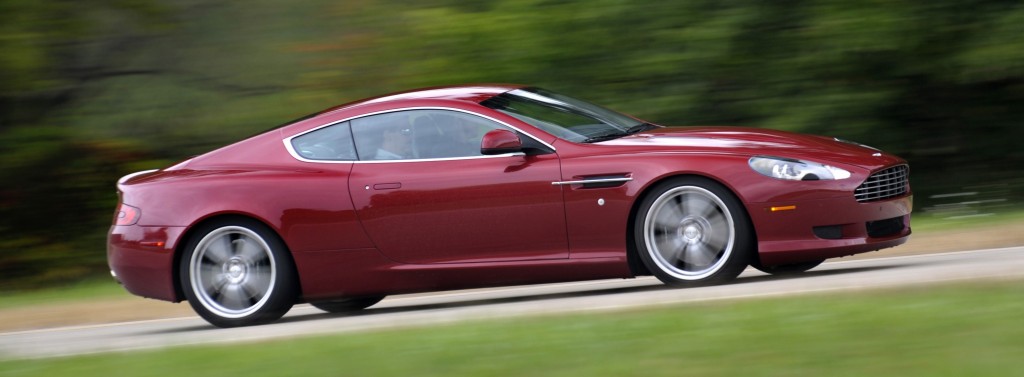First Drive: 2010 Aston Martin DB9
[svgallery name=”10_Aston_DB9″]
Story by John LeBlanc. Photos by Aaron Kiley.
ROMEO, Mich.–Gone are the days when Aston Martin would roll out a handful of expensive 2+2 grand touring coupes and then knock off for tea and crumpets. From a low of only 30 cars built in 1982, the British automaker made just under 1,000 cars in 2003, and as many as 7,000 a couple of years ago.
Currently, there are the entry-level Vantage V8 two-seaters that go for Porsche 911 money. At the other end of the lineup is what the company calls its “ultimate expression”: the 700 horsepower million-dollar-plus V12 carbon-fibre bodied One-77.
Then there’s the future.
Aston Martin has plans to launch a Toyota-based city car (Cygnet), four-door hatchback (Rapide) and is considering reviving the long-dead Lagonda badge on – of all things – a sport-utility-vehicle.
Understandable, then, that among all this hubbub and activity, the car that has solidly kept Aston Martin in the black financially sometimes gets lost in the shuffle.
We’re talking about the 2010 Aston Martin DB9 2+2 grand touring coupé. With more than 10,000 sold around the world since its debut in 2003, it surpassed its predecessor – the DB7 – to become the most successful Aston Martin ever.
Still achingly gorgeous after six years on the road, the DB9 was the first car to be hand-made at the company’s modern facility in Gaydon, England.
It was also the first Aston Martin to use the company’s new flexible platform known internally as VH – for “vertical horizontal” – that also underpins the two-seater Vantage and top-line DBS.
Starting at $198,495, the DB9 Coupé roughly splits the price difference between the $135,496 Vantage and $303,495 DBS coupés.
The 2010 example we drove here in the wilds of Michigan also came with a new-for-2010 $8,375 Bang & Olufsen sound system (the one where the tweeters rise up out of the front dash) and the $5,000 Touchtronic six-speed automatic gearbox that you can choose over the six-speed manual box.
BMW M6, Jaguar XKR or Maserati Gran Turismo S owners may brag that their 2+2 grand touring coupés offer similar performance for a lot less money.
However, they all possess four less cylinders than the DB9’s V12 engine. Hence, the Aston Martin’s only real rival is Ferrari’s V12 2+2 GT, the 612 Scaglietti. And its $300,000-plus asking price makes the Aston Martin look like a Portobello Road bargain.
With its classic long-hood, short-tail proportions, swept-back front fenders and dominating rear haunches, it’s safe to say a few DB9s have been sold on looks alone.
The interior is almost as gorgeous. Sitting in the DB9’s front seats at rest will have you closing your eyes and thinking of the Queen.
Beyond the deliciously detailed metal-faced gauges, speaker grilles created in perforated metal and column-mounted shift paddles in magnesium, a coat of hand-stitched leather (that makes an infant’s bottom seem like sandpaper) clothes every surface, even the ridiculously tight rear pair of spousal seats.
When you’re playing with Ferraris, though, good looks can only go so far. At this level, performance expectations are admittedly high.
Here the DB9 doesn’t disappoint.
Revised last year, the Aston Martin’s 6.0-litre V12 now pumps out 470 hp and 443 lb.-ft. of torque. With the Touchtronic autobox, the company says the big GT will go 0-to-96 km/h in 4.8 seconds; about two-tenths slower than a DB9 with a manual transmission, and around a 0.5 of a second behind the Ferrari.
Maximum speed is rated 306 km/h. On the Ford Proving Ground’s eight-kilometre, high-banked oval, I chickened out just past 270 km/h.
But it’s the aural delights of the DB9’s velvety V12, once the tach needle ticks by 4000 r.p.m., that makes the biggest impression. It also helps that the rear, mid-mounted autobox blips the throttle on downshifts and changes gears nearly instantly. And unlike other manumatics, Touchtronic holds each gear without upshifting; even at the 6900 rpm redline.
The 1,760 kg DB9 Coupé is no flyweight sports car. Its ride is relatively firm, but that means controlled body motions and balanced cornering. In the really tight and twisty stuff, the Aston Martin stays remarkably flat and composed, making it easy to drive fast.
For such a relatively big and heavy GT, the Aston Martin’s steering is delightfully light and very accurate. Even with all of that torque, you’ll have to be driving like a valet parking attendant to get the DB9 to hang its tail out.
Arguably, the 2010 DB9 is the most complete and thoroughly engineered Aston Martin grand touring coupé ever.
Add to the mix its exquisite interior and real-world driving capabilities, and even after six years on the road, the DB9 still stands out as one the great GTs of our time.
2010 Aston Martin DB9
PRICE: (base/as-tested) $198,495/$211,870
ENGINE: 6.0 L V12
POWER/TORQUE: 470 hp/443 lb.-ft.
FUEL ECONOMY: City 17.3 L/100 km (16 mpg), hwy. 10.4 L (27 mpg)
COMPETITION: BMW M6, Ferrari 612 Scaglietti, Jaguar XKR, Maserati Gran Turismo S
WHAT’S BEST: Achingly beautiful exterior; interior jammed with real leather, wood and aluminum; plenty of performance
WHAT’S WORST: Not exactly “sports car” agile; back seat
WHAT’S INTERESTING: The Aston Martin GT received its own category on BBC’s Top Gear: the “DB9 Super Cool Fridge.”
Comments
One Response to “First Drive: 2010 Aston Martin DB9”







![[del.icio.us]](https://www.straight-six.com/wp-content/plugins/bookmarkify/delicious.png)
![[Digg]](https://www.straight-six.com/wp-content/plugins/bookmarkify/digg.png)
![[Facebook]](https://www.straight-six.com/wp-content/plugins/bookmarkify/facebook.png)
![[Google]](https://www.straight-six.com/wp-content/plugins/bookmarkify/google.png)
![[Reddit]](https://www.straight-six.com/wp-content/plugins/bookmarkify/reddit.png)
![[StumbleUpon]](https://www.straight-six.com/wp-content/plugins/bookmarkify/stumbleupon.png)
![[Twitter]](https://www.straight-six.com/wp-content/plugins/bookmarkify/twitter.png)
![[Email]](https://www.straight-six.com/wp-content/plugins/bookmarkify/email.png)
March 22nd, 2011 @ 1:49 am
[…] has filled out the lineup, introducing six new, separate model ranges, from the DB7’s 2004 DB9 successor to the over-$1-million One-77 supercar to the Toyota iQ-based Cygnet luxury city car […]